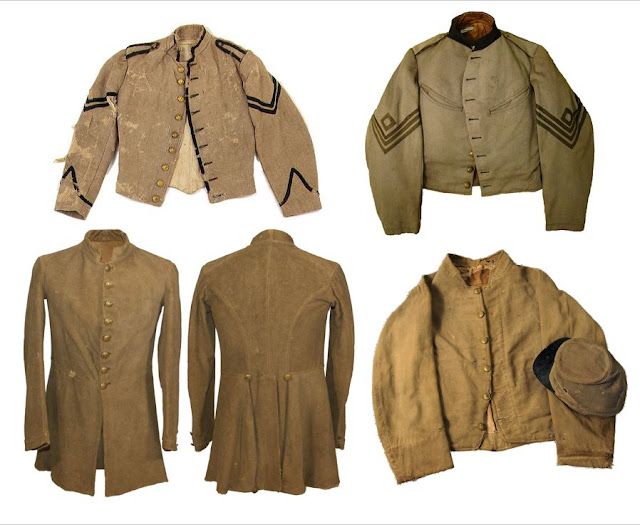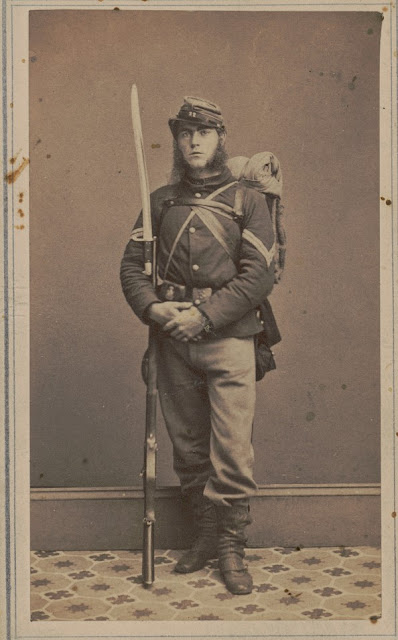With the Wagons at the Battle of Atlanta
It was noon on July 22, 1864. Quartermaster Sergeant Charles Wiles of the 78th Ohio was well behind the lines with the divisional wagon train, or so he thought.
"
Sergeant Wiles’ account of the epic Battle of Atlanta first saw publication in the August 11, 1864, edition of the Zanesville Daily Courier.
Camp near
Atlanta, Georgia
July 29, 1864
Dear
brother,
Your letter mailed the 16th
I received several days since together with one mailed the 13th
containing stamps, combs, and good news generally. The combs, each of which I
tried immediately upon opening the letter, give entire satisfaction. Both
letters I assure you would have been answered ere this had we not been on the
move constantly ever since their receipt. Today we (I refer to our train) are encamped
upon a hill by the side of a beautiful creek while the 78th Ohio is
on the battle line monetarily expecting an attack from the Johnnies.
The past 10 days have been days of
remarkable as well as sad events. Many an undaunted Rebel is today non est,
being summarily discharged by Yankee bullets and many, very many more, are incapacitated
by wounds from ever bearing arms again against their country and their own best
interests, while a comparatively large number are our prisoners, being taken in
as the boys familiarly term it. Would to God that they were all taken in or
forced to surrender and forced to sue for peace; this is my prayer.
I will give you an outline of our
history during the past two weeks. Leaving our position on the right the
morning of July 16, we arrived at Marietta the evening of the same day. The
place presents a gloomy aspect though once perhaps the seat of wealth and prosperity
as well as Southern chivalry and refinement. Leaving Marietta the morning of
the 17th, we passed through Roswell, the seat of the Roswell
Factory, rather extensively engaged in the manufacture of clothing for the
Rebel government, but now almost totally destroyed, having been burned by the
16th Army Corps which passed the that place on the 29th.
Crossing the far-famed Chattahoochee
River at this place and marching some 3 miles distant, we encamped for the
night. The three days following were consumed with reaching Decatur, being on
the railroad running to Charleston, South Carolina, which road was at once
destroyed for some distance. Decatur, like all Southern towns through which the
army passes, is dilapidated and almost wholly deserted by the inhabitants. Our
corps, the 17th, moved up and took position on the left during the
afternoon of the 20th.
On the 21st, heavy
skirmishing was kept up during the entire day while the Rebels occupied the
night massing their forces on our flank and the left center, held by Logan’s 15th
Corps which expected movement of the Johnnies, was not discovered until the
morning of the 22nd by our officers when considerable exertion was
made to meet it. Nevertheless, this day was destined to be the scene of a
dreadful battle. At noon while our teams were corralled in the rear of our
brigade, we were somewhat surprised at the appearance of a battery taking
position on a hill just above us and the forming of a line of battle by a
detachment of the 16th Corps. The sight was really beautiful, but
foreboding of a fight, the character and approach of which we as yet knew
nothing about.
We were at once on the alert with
everything in the wagons awaiting orders from our brigade quartermaster to move
out. Five minutes had scarcely elapsed when we were ordered to move; the whips
cracked sharply over the mule’s backs and we were moving hastily to the rear
(if any there was) while the above mentioned battery started throwing its
deadly missiles among the ranks of the advancing Rebels. At this moment, I
snatched from a wagoner our old split-bottomed chair which I stood upon and
watched the fiend-like Rebels as they filed through an embrasure in the woods
some 300 yards distant. Soon they came to a front then a charge ensued; such
musketry and artillery firing! The bullets flew as thick as hail and the shells
burst in every direction. Health and self-preservation prompted me to find a
more secure position as I was totally unarmed and had no business anywhere
except with our teams.
 |
| General James B. McPherson commanding the Army of the Tennessee was killed in one of the opening moves of the Battle of Atlanta. |
At this junction, the Rebels advanced
upon our brigade in front and almost simultaneously upon their rear, compelling
the boys to climb from one side of their earthworks to the other, at the same
time discharging their pieces and clubbing the Rebs from the works with the
pieces reversed. Terrible was the conflict but like devils, our boys repulsed
every onset until the Rebs lay in piles right in their own ditches, still
holding their position. The color guards of the 78th Ohio were all
shot down and one of the Rebs in the very act of seizing the colors was sent
howling back by a blow from Captain Orr’s saber; the beautiful colors still waved
defiantly not destined to be polluted by Rebel hands. Thus, the battle raged
until late in the afternoon when comparative quiet was restored.
Now could be heard the moaning of the
wounded, heart-rending in the extreme. The living looked around them in search
of their missing comrades, finding some while the fate of others remained unknown.
After a night of anxious solicitude, the morning of the 23rd dawned
and the boys resumed the search among the dead and wounded for their missing comrades
finding one dead here, another wounded there, and so on. Suffice it to say that
the loss in our regiment in killed, wounded, and missing was 111 men.
Such a battle the veterans of the 78th
Ohio say they never participated in or ever wish repeated. For my part, I would
feel contented should I never again be compelled to witness such a terrible
battle. The general health of the regiment is not so good as might be expected.
Diarrhea and flux prevail to some extent. My health continues good notwithstanding
the oppressively hot weather we are experiencing. The colonel is now in command
of the brigade, its former commander having been captured during the battle of
the 22nd. J.P. Springer and son are both well although they are
constantly on the go transferring sick and wounded from the field to the
hospitals.
The fate of Atlanta is sealed, it being only a question of time with General Sherman as to when it shall be taken.
Source:
Letter from
Quartermaster Sergeant Charles C. Wiles, 78th Ohio Volunteer
Infantry, Zanesville Daily Courier (Ohio), August 11, 1864, pg. 2











Comments
Post a Comment